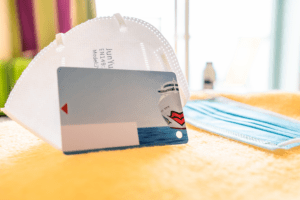9/20/21—The COVID-19 pandemic has taken a tragic toll on the lives of millions of people, with recent numbers from the World Health Organization (WHO) reporting 4.6 million deaths and over 226 million cases worldwide since the start of the pandemic.1 The devastating health effects, paired with ongoing lockdowns, variants, and struggles to return to normalcy have taken a mental health toll on the world too. Caring for your mental health not only protects your day-to-day wellbeing and cognitive function, but your physical health too, as mental disorders can raise your risk for physical health problems such as stroke, type 2 diabetes and heart disease.2
Studies conducted since the beginning of the pandemic convey a decrease in overall mental health. At the start of the pandemic, the number of U.S. adults who said COVID-related worry and stress had a negative impact on their mental health went up from one-third (32%) in March 2020 to roughly half (53%) in July 2020.3 The same study from the Kaiser Family Foundation reported in March 2021 that 47% of adults continue to show negative mental health impacts related to the pandemic.
There are several reasons for this increase, including fear of getting sick, worry for friends and family, loss of a loved one due to COVID, isolation related to lockdowns and social distancing, lack of childcare and schooling, and COVID-related job loss. With all of these factors, it is no wonder that from August 2020 to February 2021, the number of adults with anxiety or a depressive disorder symptoms climbed from 36.4% to 41.5%, as did the number of people reporting they felt a need for therapy or counseling, but could not receive it, from 9.2% to 11.7 percent.4 These numbers beg the question, what can be done to help alleviate the mental strain of the pandemic?
Thankfully there are effective steps to promoting your mental health, as we navigate the pandemic. The Centers for Disease Control and Prevention (CDC) recommends several tips, including regular breaks from the news and social media, which you can do with apps that limit screen time or by setting times of the day where you will not engage with screens or read newspapers. The CDC also recommends taking care of your physical health by sleeping well, drinking plenty of water, avoiding or limiting substances like alcohol and tobacco, and maintaining healthy diet and exercise. Exercising daily is a powerful tool, as exercise reduces the body’s stress hormones, and increases production of endorphins, which are natural mood elevators.5 Even if you simply take a walk outside by yourself or with a friend, moving around and allowing time for physical activity can yield positive results.
Connection with others is another recommendation by the CDC, which can help combat feelings of isolation and loneliness. Reach out to loved ones regularly, checking in on their mental wellbeing too. Contacting local community groups such as churches, volunteer organizations and activity clubs can facilitate further connection with the outside world. While you should still maintain and practice social distancing, vaccinated people are generally safe to be around other vaccinated people in well-ventilated and small groups. If you are practicing total isolation, consider using video chat applications to meet up with family and friends.
The CDC also advises seeking professional help if you begin to feel overwhelmed by your mental health. Counseling or therapy can help you cope with mental distress caused by COVID. While many mental health practices closed their offices for social distancing purposes, mental health services are now being offered online via virtual chats and videos, to connect to clients in need. You can also reach out to your healthcare provider or primary care manager for referrals to mental health services in your area. For some, mental health providers may not always be affordable, thankfully there are a number of free services available in many areas and online. The CDC provides information on free services available, which you can utilize if you feel your mental health is in need of professional help.
For those returning to work, maintaining mental health in the workplace is key to not only protecting employees, but ensuring they are functioning at their best. When returning to work, ensure employees are protected by practicing social distancing, masking and hand washing hygiene, along with effective contact tracing, with tools like AlertTrace. Taking these proactive measures can help employees feel a sense of mental ease knowing that their health is a priority in the workplace. With assistance programs such as the American Rescue Plan, businesses can also ensure that employees are not stressed by needed sick leave, as ARP provides tax credits and funding to pay employees through sick leave and even to take time off to receive vaccines.6
As the world works to make it through the COVID-19 pandemic, it is more imperative than ever that communities stick together, and businesses work to keep their employees safe. Check in on your loved ones, and remember that your mental health matters too, so don’t forget to set aside time for yourself and seek help if you need it.
…
National Mental Health Institute: Find Help
…
1 World Health Organization. (n.d.). Who coronavirus (COVID-19) dashboard. World Health Organization. Retrieved September 20, 2021, from https://covid19.who.int/.
2 U.S. National Library of Medicine. (2021, September 1). Mental health. MedlinePlus. Retrieved September 20, 2021, from https://medlineplus.gov/mentalhealth.html.
3 Audrey Kearney Follow @audrey__kearney on Twitter, L. H. F. @lizhamel on T., & 2021, A. (2021, April 14). Mental health impact of the COVID-19 pandemic: An update. KFF. Retrieved September 20, 2021, from https://www.kff.org/coronavirus-covid-19/poll-finding/mental-health-impact-of-the-covid-19-pandemic/.
4 Centers for Disease Control and Prevention. (2021, April 1). Symptoms of anxiety or depressive disorder and use of mental health care among adults during the COVID-19 pandemic – United States, August 2020–February 2021. Centers for Disease Control and Prevention. Retrieved September 20, 2021, from https://www.cdc.gov/mmwr/volumes/70/wr/mm7013e2.htm.
5 Exercising to relax – Harvard Health Publishing. Harvard Health. (2020, July 7). Retrieved September 20, 2021, from https://www.health.harvard.edu/staying-healthy/exercising-to-relax#:~:text=Exercise%20reduces%20levels%20of%20the,natural%20painkillers%20and%20mood%20elevators.
6 Employer tax credits for employee paid leave due to covid-19: Internal Revenue Service. Employer tax credits for employee paid leave due to COVID-19 | Internal Revenue Service. (n.d.). Retrieved September 20, 2021, from https://www.irs.gov/newsroom/employer-tax-credits-for-employee-paid-leave-due-to-covid-19.




